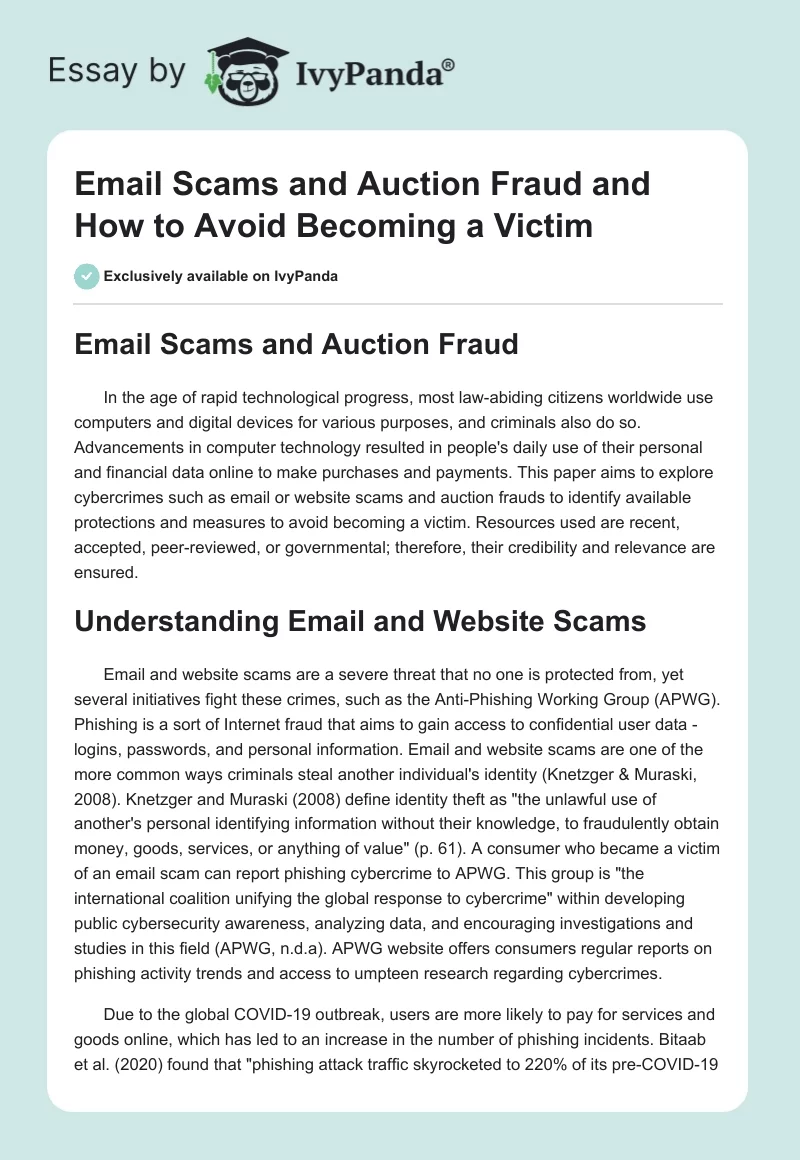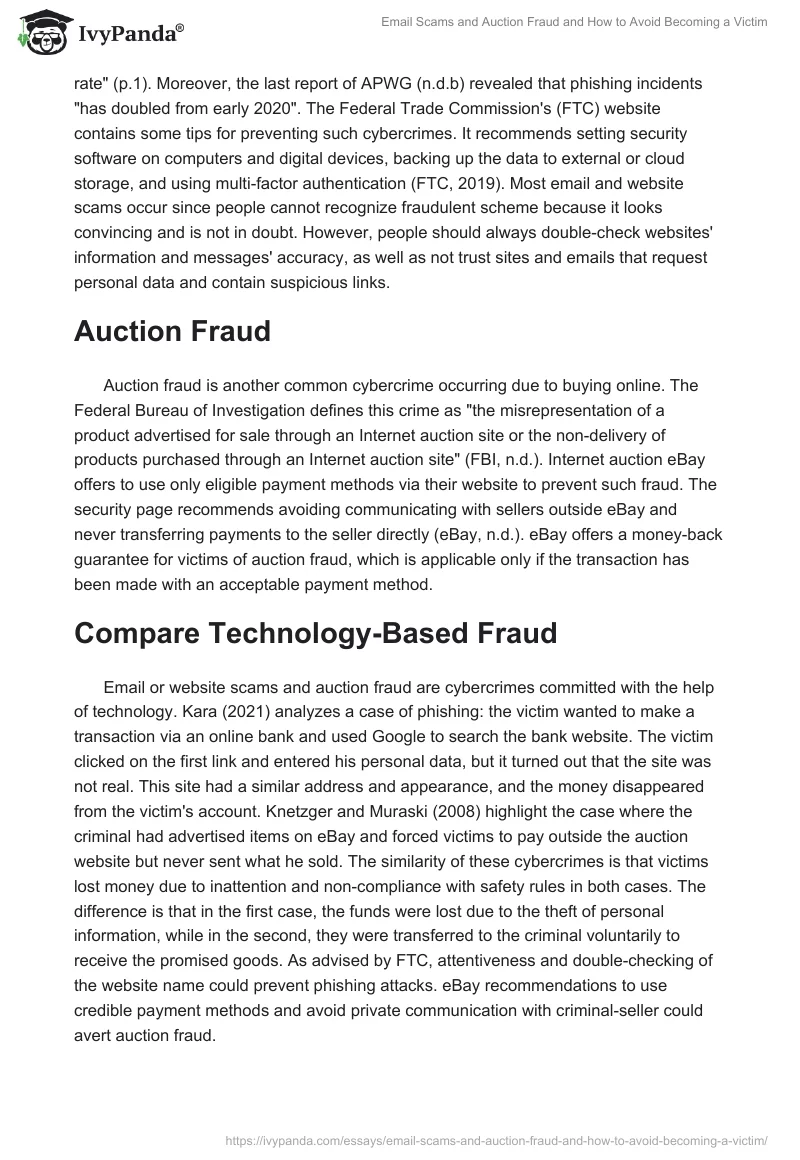Email Scams and Auction Fraud
In the age of rapid technological progress, most law-abiding citizens worldwide use computers and digital devices for various purposes, and criminals also do so. Advancements in computer technology resulted in people’s daily use of their personal and financial data online to make purchases and payments. This paper aims to explore cybercrimes such as email or website scams and auction frauds to identify available protections and measures to avoid becoming a victim. Resources used are recent, accepted, peer-reviewed, or governmental; therefore, their credibility and relevance are ensured.
Understanding Email and Website Scams
Email and website scams are a severe threat that no one is protected from, yet several initiatives fight these crimes, such as the Anti-Phishing Working Group (APWG). Phishing is a sort of Internet fraud that aims to gain access to confidential user data – logins, passwords, and personal information. Email and website scams are one of the more common ways criminals steal another individual’s identity (Knetzger & Muraski, 2008). Knetzger and Muraski (2008) define identity theft as “the unlawful use of another’s personal identifying information without their knowledge, to fraudulently obtain money, goods, services, or anything of value” (p. 61). A consumer who became a victim of an email scam can report phishing cybercrime to APWG. This group is “the international coalition unifying the global response to cybercrime” within developing public cybersecurity awareness, analyzing data, and encouraging investigations and studies in this field (APWG, n.d.a). APWG website offers consumers regular reports on phishing activity trends and access to umpteen research regarding cybercrimes.
Due to the global COVID-19 outbreak, users are more likely to pay for services and goods online, which has led to an increase in the number of phishing incidents. Bitaab et al. (2020) found that “phishing attack traffic skyrocketed to 220% of its pre-COVID-19 rate” (p.1). Moreover, the last report of APWG (n.d.b) revealed that phishing incidents “has doubled from early 2020”. The Federal Trade Commission’s (FTC) website contains some tips for preventing such cybercrimes. It recommends setting security software on computers and digital devices, backing up the data to external or cloud storage, and using multi-factor authentication (FTC, 2019). Most email and website scams occur since people cannot recognize fraudulent scheme because it looks convincing and is not in doubt. However, people should always double-check websites’ information and messages’ accuracy, as well as not trust sites and emails that request personal data and contain suspicious links.
Auction Fraud
Auction fraud is another common cybercrime occurring due to buying online. The Federal Bureau of Investigation defines this crime as “the misrepresentation of a product advertised for sale through an Internet auction site or the non-delivery of products purchased through an Internet auction site” (FBI, n.d.). Internet auction eBay offers to use only eligible payment methods via their website to prevent such fraud. The security page recommends avoiding communicating with sellers outside eBay and never transferring payments to the seller directly (eBay, n.d.). eBay offers a money-back guarantee for victims of auction fraud, which is applicable only if the transaction has been made with an acceptable payment method.
Compare Technology-Based Fraud
Email or website scams and auction fraud are cybercrimes committed with the help of technology. Kara (2021) analyzes a case of phishing: the victim wanted to make a transaction via an online bank and used Google to search the bank website. The victim clicked on the first link and entered his personal data, but it turned out that the site was not real. This site had a similar address and appearance, and the money disappeared from the victim’s account. Knetzger and Muraski (2008) highlight the case where the criminal had advertised items on eBay and forced victims to pay outside the auction website but never sent what he sold. The similarity of these cybercrimes is that victims lost money due to inattention and non-compliance with safety rules in both cases. The difference is that in the first case, the funds were lost due to the theft of personal information, while in the second, they were transferred to the criminal voluntarily to receive the promised goods. As advised by FTC, attentiveness and double-checking of the website name could prevent phishing attacks. eBay recommendations to use credible payment methods and avoid private communication with criminal-seller could avert auction fraud.
References
Anti-Phishing Working Group. (n.d.a). About us. Web.
Anti-Phishing Working Group. (n.d.b). Phishing activity trends reports. Web.
Bitaab, M., Cho, H., Oest, A., Zhang, P., Sun, Z., Pourmohamad, R., Kim, D., Bao, T., Shoshitaishvili, Y., Doupe, A., & Ahn, G. J. (2020, November). Scam pandemic: How attackers exploit public fear through phishing. 2020 APWG Symposium on Electronic Crime Research, 1–10. Web.
eBay. (n.d.). Stay safe from scammers. Web.
Federal Bureau of Investigation. (n.d.). Internet auction fraud. Web.
Federal Trade Commission. (2019). How to recognize and avoid phishing scams. Web.
Kara, I. (2021). Don’t bite the bait: Phishing attack for internet banking (e-banking). Journal of Digital Forensics, Security and Law, 16(2). Web.
Knetzger, M. R., & Muraski, J. A. (2008). Investigating high-tech crime. Pearson/Prentice Hall.


